In order to answer your request, we are obligated to process the data given above. Sometimes, however, we would like to use them for slightly different purposes, such as statistical data or informing you about our new products and services.We promise that we will use the given information for communication purposes only. We also remind you that you can unsubscribe from our mailing at any time (see Privacy Policy).
If you’ve ever shopped in a new online shop before, you’ve most definitely asked yourself if that shop was trustworthy or not. How did you decide whether it was or not? Today, we’ll have a look at 5 ways you can build up customer trust for your online store.
Before we get to the five tips, there is one over-arching theme that will be present throughout this article: transparency. Being transparent is an important part of building trust. Think about the relationships you have with friends and colleagues. There is a level of transparency that you expect from those close to you. This concept carries over into our business relationships as well.
Therefore, make sure to keep transparency in mind whenever you’re analysing and optimising any element of your online shop, even beyond the tips you’ll read about now. With that in mind, let’s get to it. Here are 5 ways to build trust in your online shop:
Make an About Us page
Creating (or optimising) an About Us page is one of the fastest and easiest things you can do to increase customer trust in your online store.
When online shoppers arrive on a new website, there’s a good chance they’ll want to read a little bit about the company, especially if they’re going to spend a decent amount of money on a product from a shop they've never heard of before.
There are a number of strategies you can use when it comes to your About Us page, but all in all, you’ll want to take the opportunity to tell your story.
One common strategy is tell your “origin story”. In other words, let visitors know why you decided to open an online store in the first place. For example, if you own a golf accessories website, you can talk about your passion for golf and how it started at a young age when your grandpa would take you along to be his caddy.
If your manufacturing process makes you unique, then let users know what inspired you to do things differently. In today’s world, there are a large number of people who want to shop from smaller businesses. They also want to buy from responsible businesses. If either of those are part of your company’s story, use it to your advantage. Building trust with your audience is not easy, so if you're doing something special, share it with the world.
Look at Warby Parker as an example. They entered a very difficult industry (eye glasses), but found success. They have an entire About Us section in their footer. Of course, you don’t have to go to those lengths, but you can! Their story is really unique and is a big part of their appeal. With a few clicks, online shoppers can learn about why the founders got into the industry (glasses were too expensive), as well as learn more about the charities they work with to get eye glasses to people in developing nations.

Warby Parker’s story is part of the brand’s appeal.
Don’t be afraid to use images either. Adding an image of the founder can really add a human touch to the business. If the owner is too shy, consider adding some images of the employees. Consumers like knowing they are buying from a business that keeps their employees happy.
No matter what strategy you decide to go with, take the opportunity to show who you are and what you’re about with an About Us page.
Collect and display customer reviews
It should be no secret at this point that customer reviews (aka social proof) can help build customer trust in your online store. And yet, for some reason, many online shops still don’t do this. So, the first step should be to collect reviews in the first place!
Online reviews can normally be broken down into two main categories: Product reviews and service reviews.
Product reviews are the feedback a shop collects in regards to the products they offer. They usually relate to the durability of the product, its value, its usefulness, etc.
Service reviews are the feedback related to the service the retailer provides. This usually relates to the delivery, packaging, and customer service provided by the shop.
Now that we have that cleared up, let’s see what benefits each bring to your shop. Customer reviews make impressions on your target audience in two main places:
- On your website
- In search engines
Let’s begin with your website:
Product reviews should be displayed front and centre on your product pages. They should be considered as important as any other element on the product page (if not, more so). Shoppers consider product reviews as the least biased aspect of your page. After all, these are opinions from other consumers, not from some marketing or sales team. That’s why it’s often referred to as social proof.
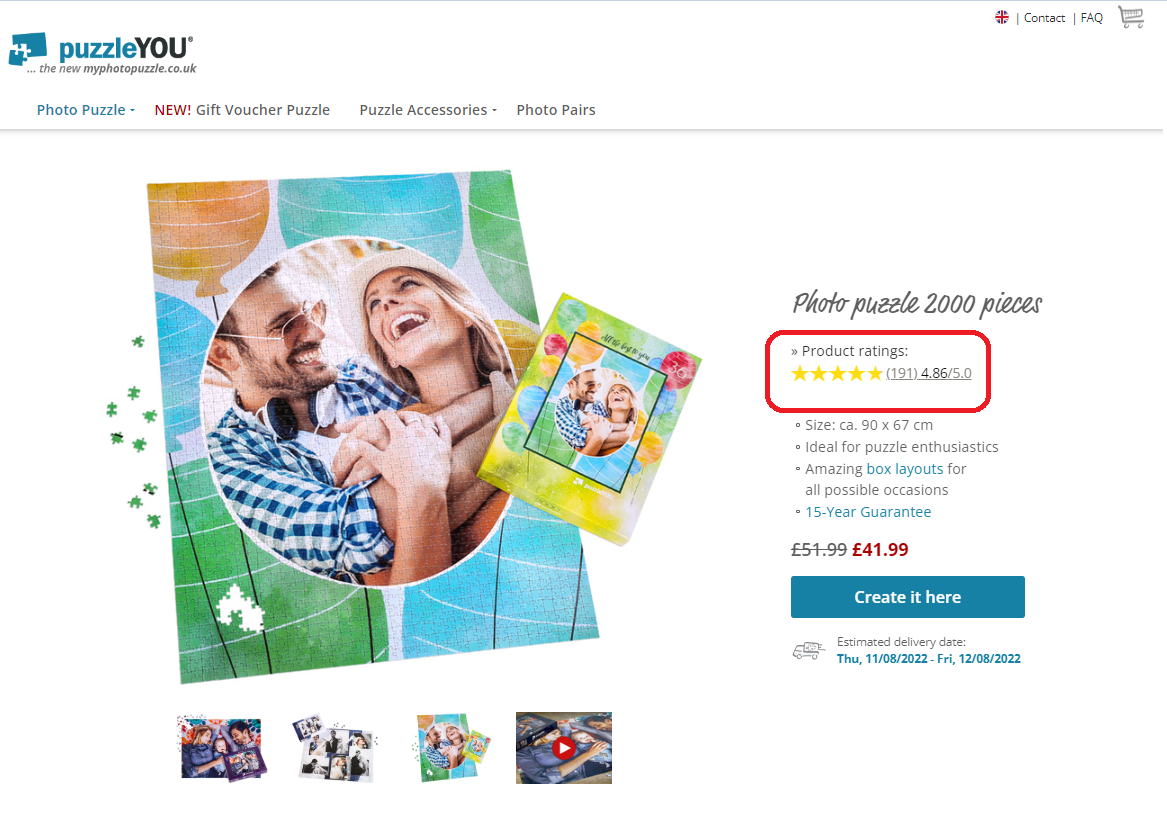
The product reviews at PuzzleYou are seen at the top of the product page.
With that said, service reviews also play a part on your website as well. They can give your site’s visitors insights into how you handle things. If you make them visible directly on your website as well, it can be a great conversion tool, especially for first-time shoppers.
On top of building trust for the products you sell, product reviews can be used to build customer trust in a range of Google Ads in the form of star-ratings. They can also appear in the organic results of search engines. In other words, online reviews can build consumer trust in your products and in your business before the consumer has even reached your website.
While product reviews build trust in your products, service reviews build customer trust in your brand. Although websites can no longer display their shop's star-ratings (or seller ratings as Google calls them) next to their own domains in Google’s organic search results, they can still show up in Google organically through third-party review providers. These service reviews can also be used to differentiate multiple sellers of the same product in Google Shopping ads as well.
Note: Your seller-ratings can still show up next to your domain in the search results if you run a Google Ad. However, they can only be displayed there if the reviews are sourced from a Google reviews partner (like Trusted Shops).
Although we’re talking about Google, it’s important to remember that a user’s experience with your shop often begins there. The famous search engine is actually where your shop makes its very first impression on your potential customers. If that first impression is a good one, it leads to clicks – and that’s already half the battle.
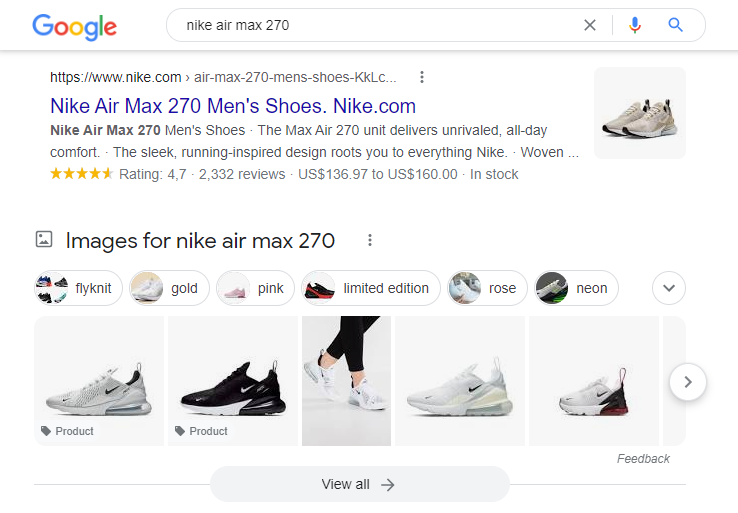
If your product appears in the search results, it’s click-through rate goes up when star-ratings appear.
One last point about customer reviews: remember to be transparent. This refers to the almost inevitable case where you get a negative review. Remember, not every review can be a positive review. In actuality, many people go out of their way to find the negative reviews when shopping online, so don’t delete the ones you do get. Don’t hide from them either. In fact, take it as an opportunity to show off your exceptional customer service. Reply to the negative review in a cool and calm way. That is a great way to build trust online.
After all, anyone who's ever gone online shopping knows things can go wrong. In fact, if these "negative review hunters" only find positive reviews, that can also raise suspicions. More often than not, people who search out negative ones just want to know how you’ll handle things in the case that something does indeed go wrong. Responding to reviews from past customers (in a good way) shows your audience that your ecommerce business cares about customer satisfaction.
Make sure your checkout is perfect
Optimising your checkout really deserves an article of its own. But the short version is that checking out should be a smooth, easy experience with no hiccups.
Window shopping through an ecommerce store can be pretty carefree until you actually find something you want to buy. As a shopper, your instincts begin to kick in when you find that special item. Suddenly, the concept of trust pops into your mind again and again: Can I trust this site? Am I going to get ripped off? How trustworthy do they look?
Again, this is where customer reviews can win them over (as well as the About Us page), but the final step (i.e. the checkout) is really the moment of truth. The checkout portion of the customer journey is when things “get real” for the shopper. That is why your checkout process needs to be perfect.
Your shop needs to get the appropriate data needed to fulfil the other. Make sure this is smooth and non-repetitive. Make it easy to choose a state, country, etc. In general, you shouldn’t ask for more data than you need and let users know how this data will be used (or not used!). After all, data privacy has become very important to many people in the last few years.
Remember, once again, to be transparent during the checkout process. Give users a chance to review their orders. Be transparent about pricing, shipping details, and any other important information for the online shopper.
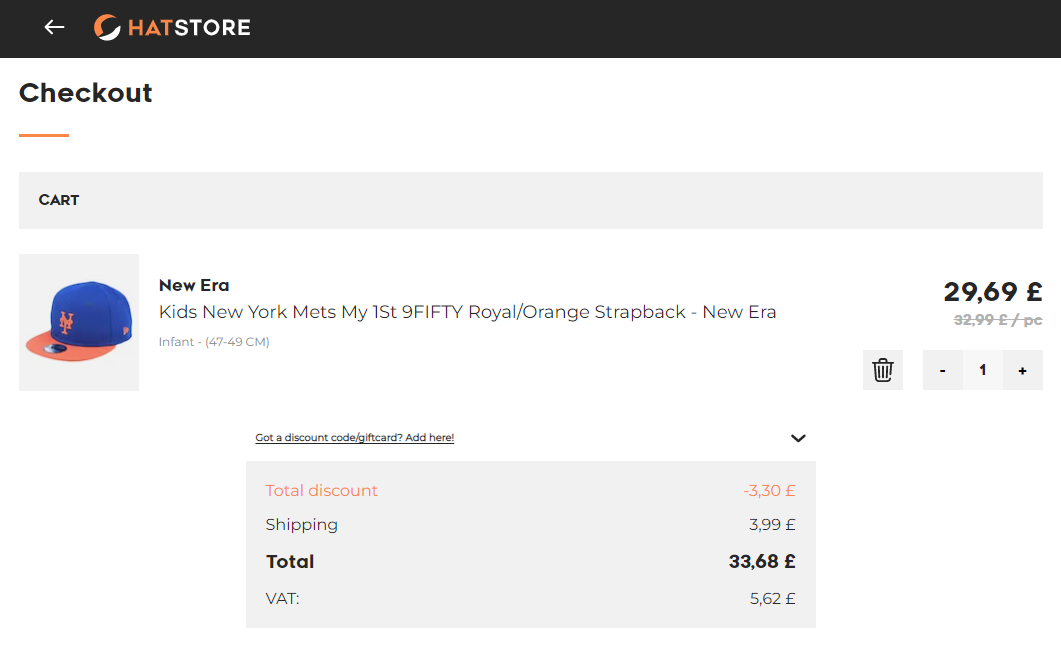
The checkout from Hatstore is very transparent about the shoppers’ costs.
It may seem like users who are in the checkout have made their decision and are ready to buy. However, until they finalise their order, the checkout is still their last chance to change their mind. That is why it’s also useful to have signs of trust here as well. This can reassure users that they are buying from a safe ecommerce site.
For example, you may want to display your shop rating here again. This reminds them that their fellow consumers have already had good experiences with your online business.
Alternatively, you can remind users of how returns work, especially if you have a “generous” return policy. Do you offer some kind of guarantee? A Buyer Protection might be incredibly useful if a shopper has their doubts, especially if it protects them from non-delivery or legal returns.
All in all, this should be a reminder to you that a sale is not a sale until they complete the purchase.
As an online shop owner, make sure to go through your checkout process. Not only that, but make sure to look at the analytics of your checkout process. Can you see where you’re losing these “cart-abandoners”? If so, try to build trust on those pages by providing more relevant information and assurances.
Create free content for your target audience
Content marketing has been around for a while. However, many online shops don’t take advantage of this strategy. This is probably because they are busy trying to fulfil orders, run marketing campaigns, and other tasks that lead directly to sales.
Of course, it’s understandable why these other tasks may take priority, but content marketing is more of a big picture thing - a long-term marketing strategy. In some cases, it may lead to direct sales, but in other ways, it’s more of a brand-building practice. It can lead to many benefits in the future, including customer loyalty.
With that in mind, let’s look at how unique content can be used to help you start building customer trust in your ecommerce business.
To be clear, content marketing refers to creating content for users with the intent of boosting your marketing efforts. Generally speaking, your content strategy should not be to “hard sell” to your target audience. Most content you produce will not be a sales brochure, but rather something that provides value to users whether they buy a product from you or not.
Some examples of this may include, but are not limited to, YouTube videos, blog articles, or downloadable posters and PDFs.
If your online business exists within a particular niche, creating engaging and useful content is a really great way to strengthen your relationship with your audience and create loyal customers. By engaging in customer interests, you're showing that you're more than just someone trying to exploit the niche.
This content can build trust online in multiple ways. For starters, it can prove that you are an authentic member of this niche’s community. Members of really specific communities like to know that your shop is involved in this industry in a real and genuine way. Much like an About Us page, you can prove your motivations and interests in that particular field.
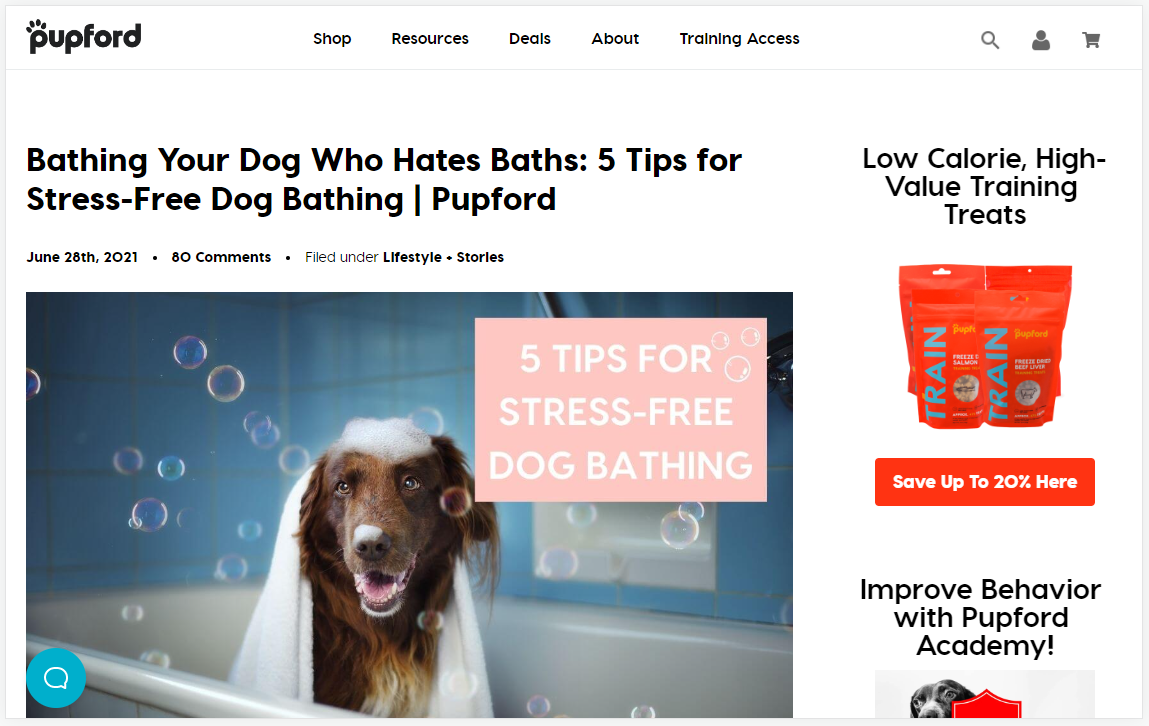
Pupford advertises their products on their company blog, which offers free advice to dog owners.
Another way you can build trust online with this audience is by giving away free advice. This can be useful to experienced users, but also to novices (or “noobs”, depending on your niche). That’s not to say that you can’t promote your products in these content pieces. You should just be subtle, and not too pushy.
For example, if you sell pet supplies, you might write an article about “5 Ways to Trick Your Dog into Bathing”. The advice will be real and it will be incredibly useful to those dog owners whose dogs hate bath time. Somewhere around tip #3, you might mention your brand of soap, which dogs love because the smell reminds them of bacon!
That's where you can simply add a link to the product page. Just don’t get into full-on “sales mode” in the article. Your product page should focus on closing the sale, but not the blog article. Someone who didn't intend to shop online that day may very well buy something if they really think it brings them value.
High quality content is also a great way to drive traffic to your website. Blog articles open up opportunities for your website to rank for keywords that are of interest to your target audience. They might not be the most important keywords for your product per se, but they are related to your niche and they can eventually lead to people discovering your brand. This can be incredibly valuable because keywords like “pet shampoo” might be hard to rank for, but “how can I get my dog to bathe?” may be a search inquiry that could be easier to rank for and still bridges the gap between a customer need and your products.
Once you've created a fair amount of content, you might even want to consider running a newsletter. Send your newest articles once a month or so - this strategy can be used for maintaining customer trust with your existing customers. Of course, you can also include information on discounts and upcoming sales in those newsletters to drive traffic to your site. Returning customers are worth their weight in gold!
Show off certificates and awards
No matter what industry your business is in, there’s a good chance there is a third-party company that can help you build trust online for your ecommerce store.
Whether it’s a matter of data security, fair trade materials and labour, vegan ingredients, or a buyer protection (as was mentioned above), it’s possible to boost trust with the help of outside sources. These certificates can be placed in your site’s footer, in the About Us page, in the checkout, or even on a dedicated landing page (or all of the above). Of course, there are many options out there so it really depends on your niche.
Alternatively, if your business has won any sorts of awards, you may want to consider showing them off on your website as well. It doesn’t matter how “big” or “small” the award is, it could be something that draws attention to the quality of your product and your popularity among industry experts. Remember, in a niche market, a “small award” can actually be a pretty big deal, so show off your accolades proudly!
In the example below, Future Shop, a Hi-Fi and A/V retailer based in the UK, sells all kinds of cables for businesses and home setups. They’ve created an About Us section in their footer that gives access to many different pages that may be of interest to potential online customers. On their main About Us page, they allude to the many awards they’ve won as well as their green initiatives. You can learn more about these awards and green policies on dedicated landing pages as well.
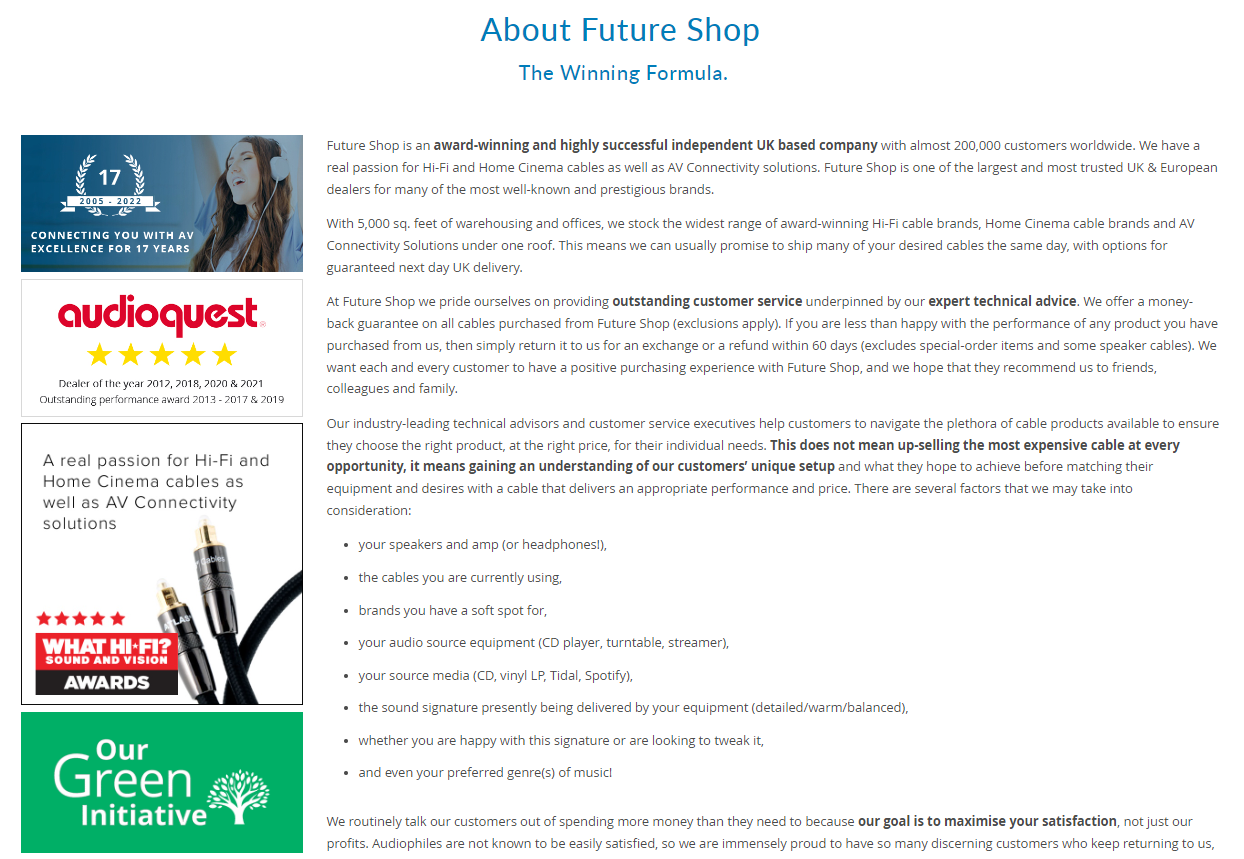
Future Shop has multiple pages dedicated to informing visitors of their accolades.
Conclusion
There are many small things you can do to increase customer trust for your online shop. The key to everything is being transparent. This will hold true for all of the good things (return policies, awards, certifications), but even some of the bad ones (negative reviews). When you are transparent about your business, consumers are more willing to put their trust in you – it’s your job to get them there quicker and easier, so make sure you put the efforts into communicating that trustworthiness.





